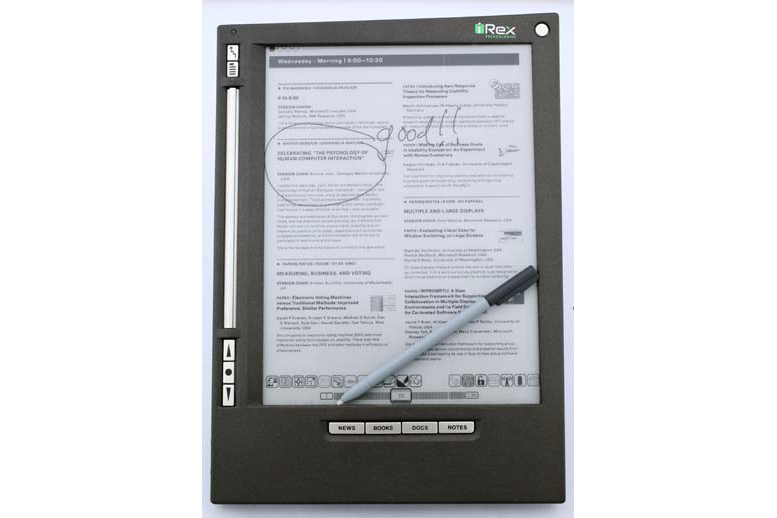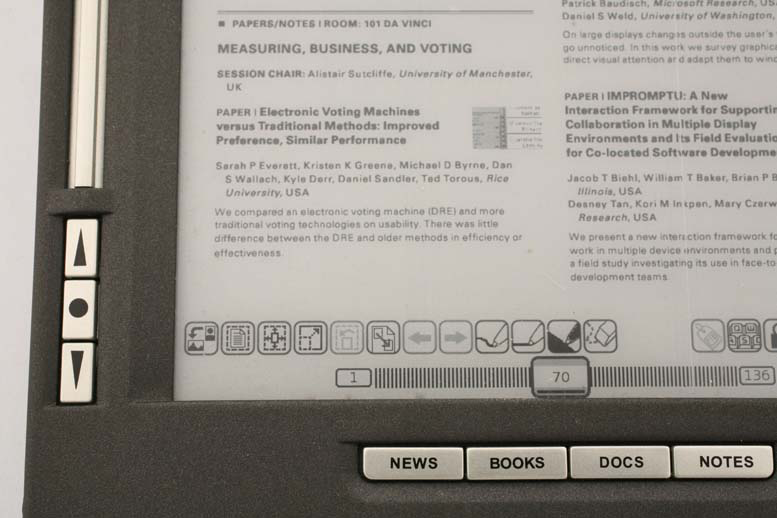|
Iliad   Bill Buxton's NotesAnnounced Dec. 2005 and shipped July 2006, this iLiad is the first e-reader that I owned. I bought it for a few reasons. To explain the primary one, namely screen size, one needs to know something about e-readers and pagination. The size of the screen of most e-readers is about the same as that of a pocket-book. Hence, if the print version of the book was in that format, then what appears on the screen can be a pretty close facsimile of the print version – especially if the original did not incorporate colour. The challenge is what to do if the book was formatted for a page larger than the screen of the e-reader? There are really three options.
As with most design options, there is generally never a single "right" (or "wrong") option. It all depends on the person doing the reading, and their intent, the nature of the material being red, and the technology being used. For me, the fact was that most of what I need the e-reader for was for unpublished documents that were in the form of PDF files formatted for 8 ½" x 11" (or A4), about 2,000 pages of which I needed to cart around with me on airplanes in 2006. Hence, I went for the e-Reader with the largest screen at the time, this one, the iLiad. But there was one other factor that made this device my choice. It was, and pretty much still is, the only e-reader that came with a high-resolution stylus, and the capability to mark up documents with digital ink, and then transfer the marked-up versions to one's PC to be sent on to the appropriate person. I loved this. At this stage, one might ask, "Why didn't you just read the documents on your Tablet-PC? It had a stylus and big screen!" Good point, and a relevant and interesting one. Largely, it had a lot to do with the quality of the reading experience, size, weight, and battery life. On planes, the experience is night and day, even taking into account how slow it is to turn pages with an e-ink display. But more to the point, I did a lot of my reading outside, sitting in our garden. That is one of the pleasures of reading. It is a pleasure that is simply not possible with any slate-format device that has an LCD display – including (and perhaps especially) the iPad. But why didn't I continue with the iLiad? The answer is rooted in a couple things, the first of which is one of my main complaints with the design of far too many digital appliances. Yes, it was wonderful to have this thin, light device with relatively long battery life. But, no, I hated the amount of paraphernalia (power supplies, cables, etc.) that I had to carry around in order to use it (remembering that "reading" the words off of the page is just part of the broader activity of reading. The other part was the quality of customer support and service. As far as I can see, iRex was never large enough or well enough funded to properly support their product. They were a classic example of the observation that it is not enough to have an innovative technology. One needs an innovative company – technologically, business-wise, and from a design perspective. They went out of business. But one last point, that plays on this last point, more than a little. The iLiad came naked – just the bare e-reader (as do most). Somewhere along the way, I bought the most expensive (circa $50) leather case for it – just to see how that affected my perception and use of the device. The fact is, I was staggered at the result. It transformed my relationship to it – even though it came close to tripling how thick it was. It was no longer some hard cold consumer electronics device. It became softer, more organic, and something that felt good to hold. There is an important lesson in this somewhere. Bill Buxton Device Details
Company: iRex |
Year: 2006 |
Original Price (USD):
$699 |
